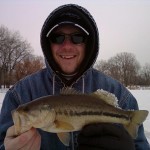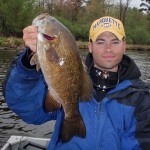By: Joe Bucher – Date Posted: May 11, 2011
If there’s one thing, above all else, that has worked well for me in my search for “active” early season muskies; it has been finding warming water. The term “active” is important here, too. It’s important to note that not all the muskies in one given lake will be where the warm water is, but it’s a good bet that the ones using that particular area are sure to be much more active. In fact, I firmly believe that pods of muskies exist in many locations throughout a larger body of water. But these individual musky pods turn on at different times depending upon time of day and prevailing weather patterns.
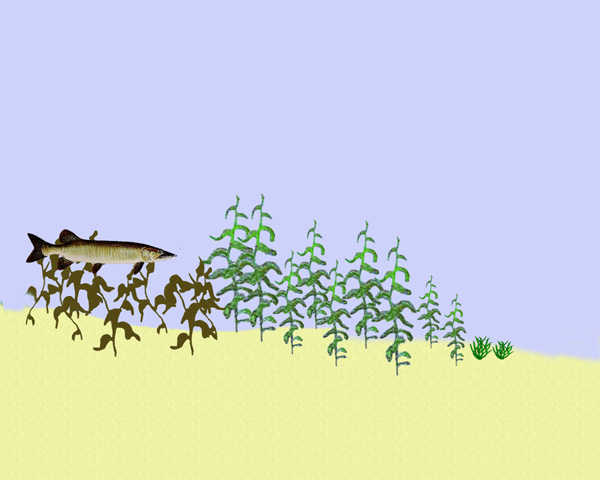
THE NORTHERN EXPOSURE RULE
A shallow north eastern bay, for example, might have a water temperature of no more than 55 – 60 degrees or so on any given morning in the early spring. If the prior night was cold and clear, it could be even colder. However, if the skies are relatively clear on that day allowing a lot of sunlight penetration, and the wind direction is northerly, this same bay is apt to warm up considerably by mid to late afternoon. It could warm up by as much as ten degrees!
This northern exposure rule works to a “t” whenever there is ample sunlight and a lack of cold wind and wave action. Any musky inhabiting this bay would most likely be non-active early in the day. In addition, the rest of the food chain that services this musky is not likely to be active early, as well. A periodic check of such a northern bay throughout your day of fishing often reveals startling developments when the conditions are right.
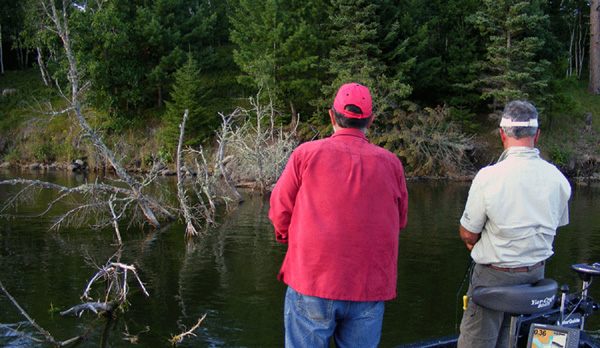
This same bay, dead and lifeless in the morning, may now have minnows cruising the warmed surface waters feeding on algae and protozoa that also just came to life with the warming water temps. It might also have a few bass, crappies and perch chasing these minnows causing a visible surface disturbance. All of this, in turn, attracts the larger predators such as pike and muskies to investigate possible feeding opportunities.
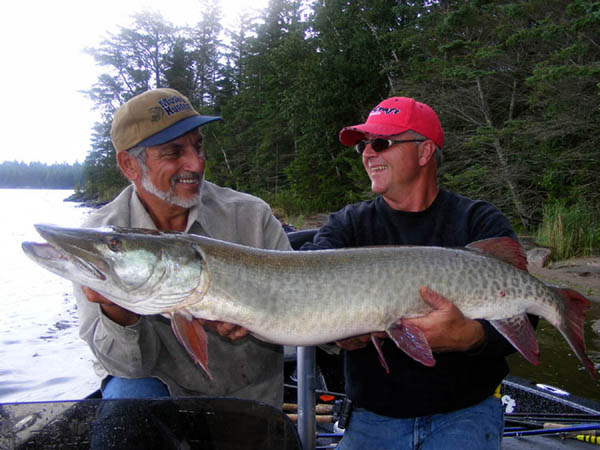
LURES
Several lures can work well on these warming bay fish, but my two favorites are the traditional bucktail spinner and a minnow bait. It’s usually best to fast-fish the bay first with the bucktail. A simple fancasting approach covering as much water as possible is generally all that is necessary to find a hot fish. Check the size of the overall bucktail lure used as well as blade size in order to determine if there are any fish preferences. While conventional wisdom might suggest a smaller lure with French style blade, don’t necessarily live and die by this. Quite often, a slightly larger 6 to 7 inch bait such as the 500 to 700 series Buchertail with a bigger fluted blade is more effective.
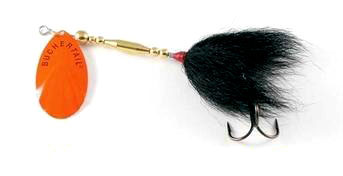
The overall height of the bay’s weed growth is a determining factor in blade choice, also. High weeds demand a larger blade or a much faster retrieve with smaller versions. Conversely, low weed growth usually means deeper holding fish. A smaller bladed model is sure to be more effective here.
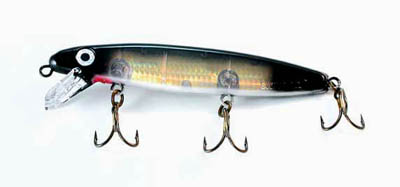
If a musky follows a bucktail, it’s usually doubtful it will hit it with repeated casts. In this case, I’d recommend a quick-switch to a five inch minnow bait such as the ShallowRaider worked in a jerk – pause – jerk – pause fashion. This is one of the best applications of a minnow bait for muskies. Bass anglers have made this technique of jerkin’ minnow baits a mainstay method, but musky anglers can be equally successful with it. It is most effective in areas where you are fairly certain you have the fish located.
SOUTH SIDERS
Contrary to popular thought, the warmest water isn’t always found on the north side of a lake. Other factors can be a surprisingly strong influence on water temperature rise. One of the largest and most surprising is a shallow southern bay that has an incoming creek or a connecting channel to an adjacent warm northerly bay from the lake next door. Any lake connected to another in a “chain” situation is a classic example of this.
The adjacent lake may be smaller and much warmer, and it might have a shallow northerly bay that has warmed all day long. The inflow of water from this smaller lake up into the southern section of the nearby lake actually makes the southern bay of one lake much warmer than it ought to be. I have recognized this unique phenomenon all across the country.
The key is to find the set of variables that match up correctly. Generally, if you’re fishing a chain of lakes, you’ll find this situation somewhere inside that given body of water in the spring.
CHANNEL CONNECTION
Channels themselves can also be musky magnets in the early season. Of course, any channel with cover is apt to attract some baitfish and spawning panfish, and with that a musky or two. However, not all channels are created equal, and some are sure to be much better than others. Narrow channels with higher shaded banks are rarely as good as ones that are sun baked and lined with small inundated coves and toppled trees. Again, the key is to find channels that attract the rest of the food chain. Warm shallow, cover laden channels with minnows, crappies, and other possible “musky bait”, are much more likely to produce an early season ‘lunge.
The best way to fish these channels quite often depends upon the layout of any given spot and the cover options available. The biggest musky ever taken in our spring musky schools during that time hit a bass spinnerbait crawled over a fallen tree. Most of this tree was protruding above the water making it tough to fish with any other lure style. Again, this is why the bass style spinnerbait is such a vital part of the spring musky fisherman’s arsenal.
The top overall channel producer in my boat has been a five inch minnow bait such as the ShallowRaider worked like a jerkbait with additional “pause” emphasis put on the lure while it was near logs, brush and weeds. More muskies were taken on this lure in channels than all other baits combined. Quite often, these fish were spotted following another lure, but were triggered on the cast back sometime later with the minnow bait.
REED RUNNERS!
Many of our favorite musky waters have large flats on them covered with reeds and bullrushes. Throughout most of the season, such cover is apt to be too shallow to attract muskies with any regularity. However, muskies gravitate heavily to reed flats in the spring. Admittedly, this is one of my favorite early season musky locational patterns and I have taken advantage of this for nearly two decades.
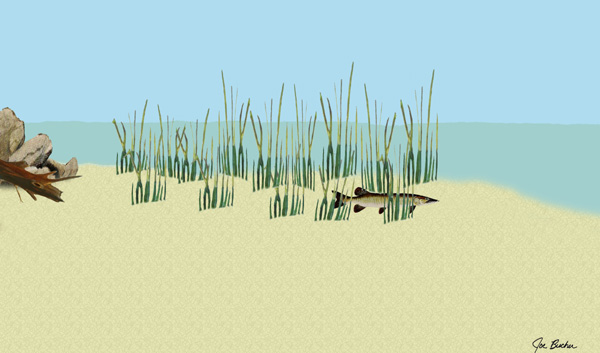
In all honesty, I stumbled onto this deadly spring reed musky pattern quite by accident a number of years ago while casting spinnerbaits for bass.
Rigging up to spinnerbait a reed flat for spring muskies is simple. I actually prefer to bass spinnerbait over any musky version for this application. The smaller overall size attracts more fish during this time, and you catch lots of bonus bass while in pursuit of a big toothy critter. I’d lean hard on a white ½ ounce spinnerbait with tandem blades featuring hammered nickel willow leaf blades. The newer models that have premium grade hooks in the 5/0 range are much better for hooking and holding muskies than older styles with lesser hooks.
For tackle, it’s tough to beat a 7 to 7 ½ foot rod and a bass sized baitcaster loaded with at least 20 pound test braid, but heavier braid is nice to have if you encounter a real hawg inside thick reeds.
The actual art of casting spinnerbaits and working them through reeds is nothing special, but you want to be aware of a few retrieve tricks. For one, this is not a tactic that works well with real fast retrieve reels, and a high rod position. Both of which tend to make the spinnerbait leap out of the water when any heavy reed contact is made. Instead, a slower geared reel and a lower rod position keep the spinnerbait in the water working at a more even keel. In fact, if you work the spinnerbait with the rod pointed right at the lure and literally retrieve the lure through reed clumps instead of pulling it with the rod, it will work perfectly most of the time and you will catch a lot more fish.
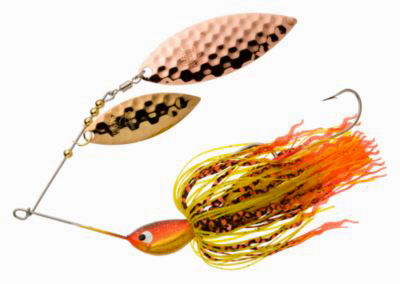
Bass sized spinnerbaits have always been one of my number one spring musky baits for reed flats, but a few other lures work well here, too. The reeds themselves restrict the use of many conventional multi- treble hook musky lures. You will find out quickly that treble hook musky baits simply hang up too much in this environment. An upriding single hook style lure is the only way to travel here. Spinnerbaits and jigs rigged with soft plastics are two of the most commonly used baits for reed muskies. In fact, sight fishing for cruising muskies with a jig & creature combo has actually become quite popular in some locales. It is very much like saltwater fishing flats for bone fish, red fish and other spring flats cruisers.
While the spinnerbait tactic seems to work best in reeds under overcast skies or strong wind conditions where visually sighting muskies is prohibitive, the jig & creature thing is best suited for bluebird skies, light winds and high visibility. The key here is to wear a good set of polarized sunglasses, stand high on the front deck of your boat and ease along the outside of a potential reedy flat with a low steady trolling motor speed visually peering ahead — trying to spot a shallow cruising or holding musky in the reeds. Once a fish is spotted, the trick is to pitch the jig/creature combo far enough ahead of the fish as not to spook it, and then retrieve it back into its site plain.
Most often, you will be able to see the musky’s reaction to the bait. A fish that turns and swims off is a tougher one to catch. However, the right fish will perk up and approach your jig. Sometimes, they will actually bolt right to it and attack all in one single motion, while other times they will stop momentarily and then snatch it as soon as it moves. In either case, set the hook as soon as you see the fish engulf the bait.
The best tackle for this application is the same stuff used for spinnerbait fishing. A flippin’ stick style rod in the 7 to 7 ½ foot range works well comboed with a good baitcaster and at least 20 pound line.
So there you have it – a very simple format for spring musky success. Find some warmer water and search out the available cover with a variety of lures including the traditional bucktail and a bass spinnerbait. Once you spot some muskies, give a few other baits a try as well until you hit on a winning formula. Then get ready for some hot spring action.
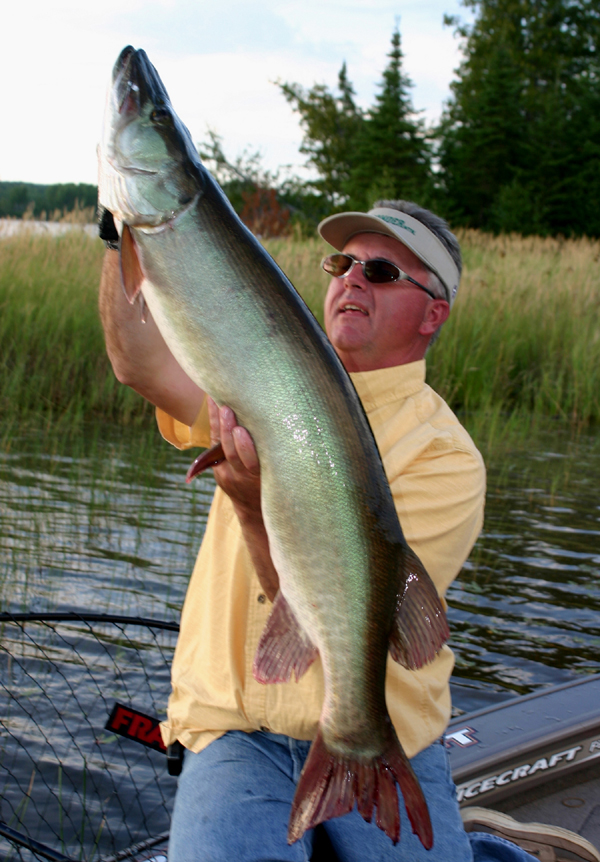
Joe Bucher can be visited online at http://www.joebucher.com



